2025 Winner
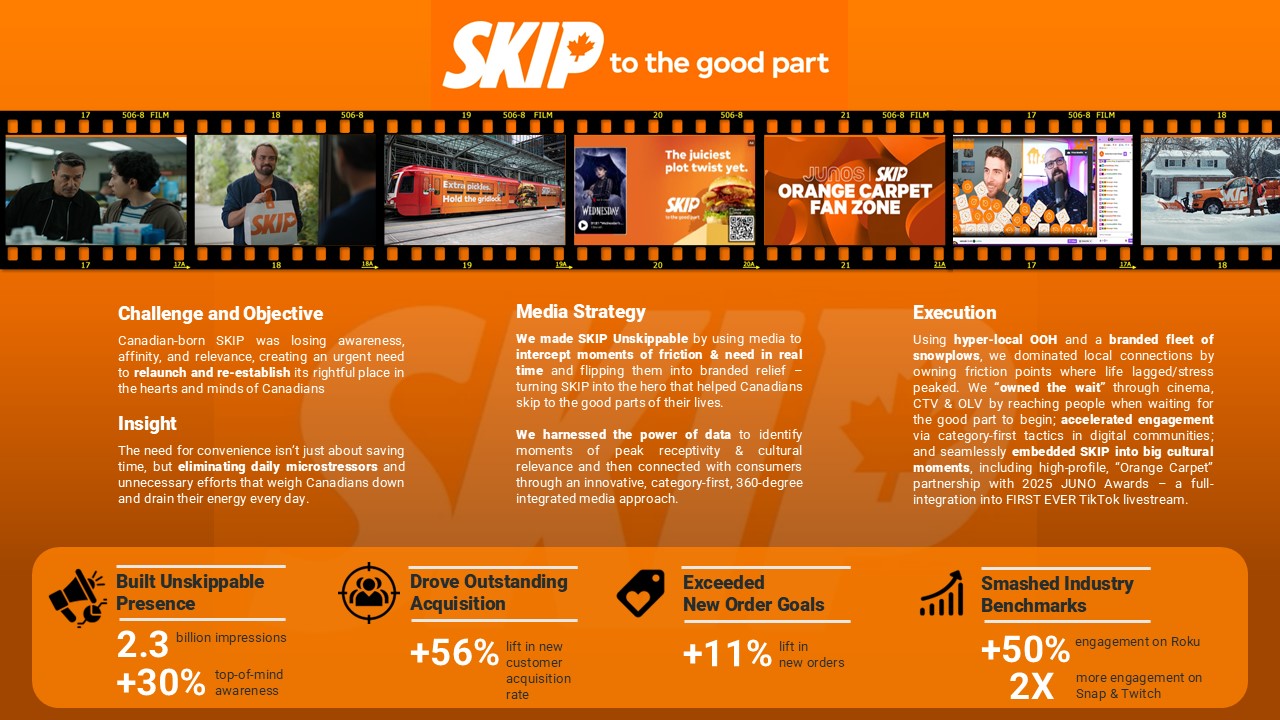
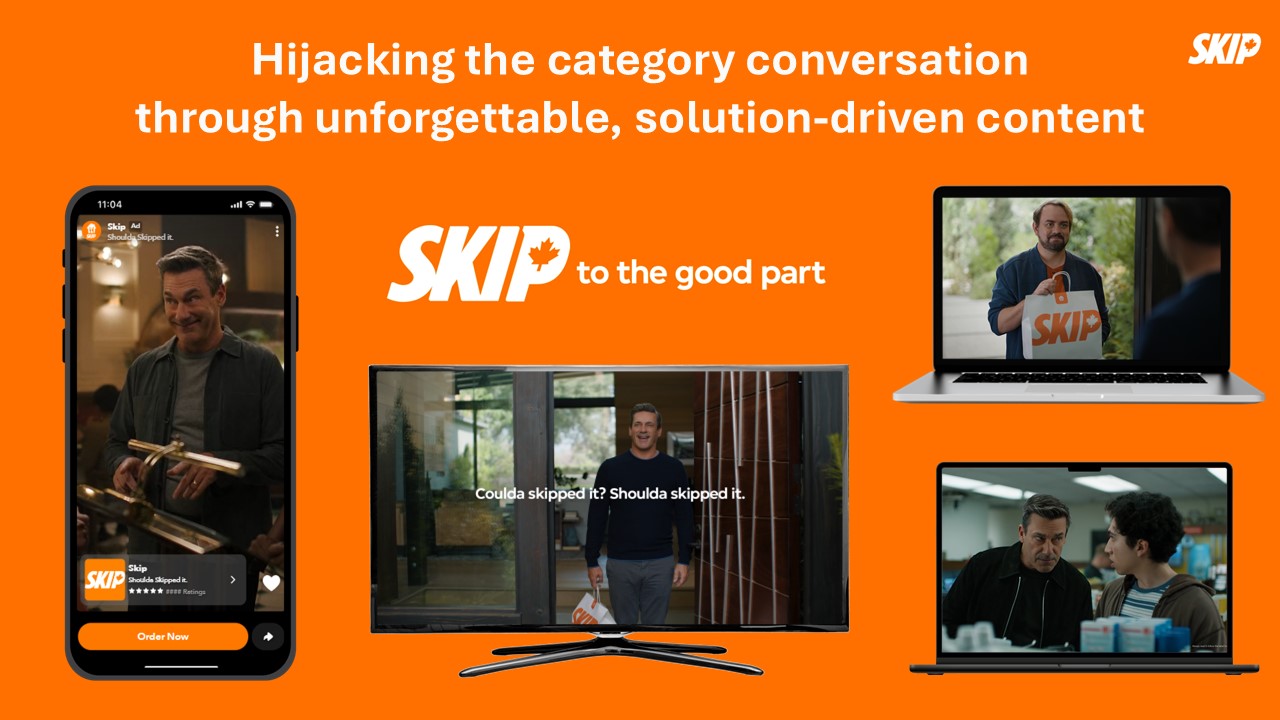

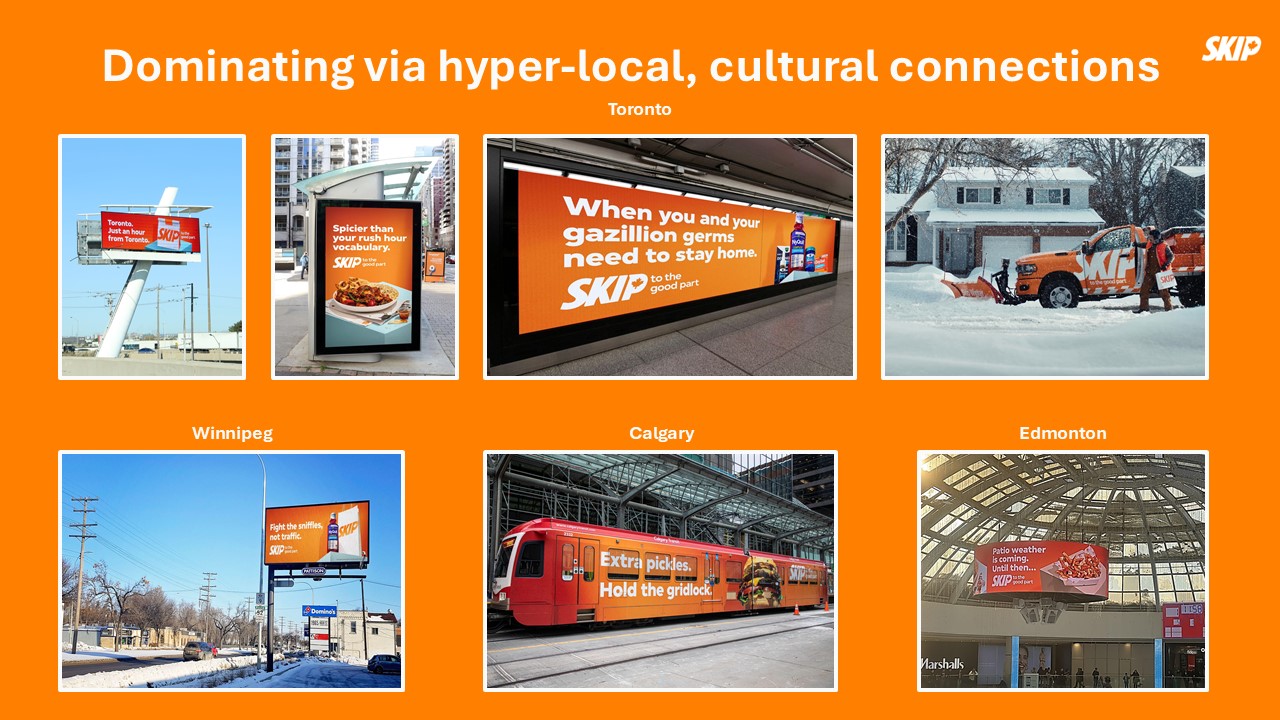
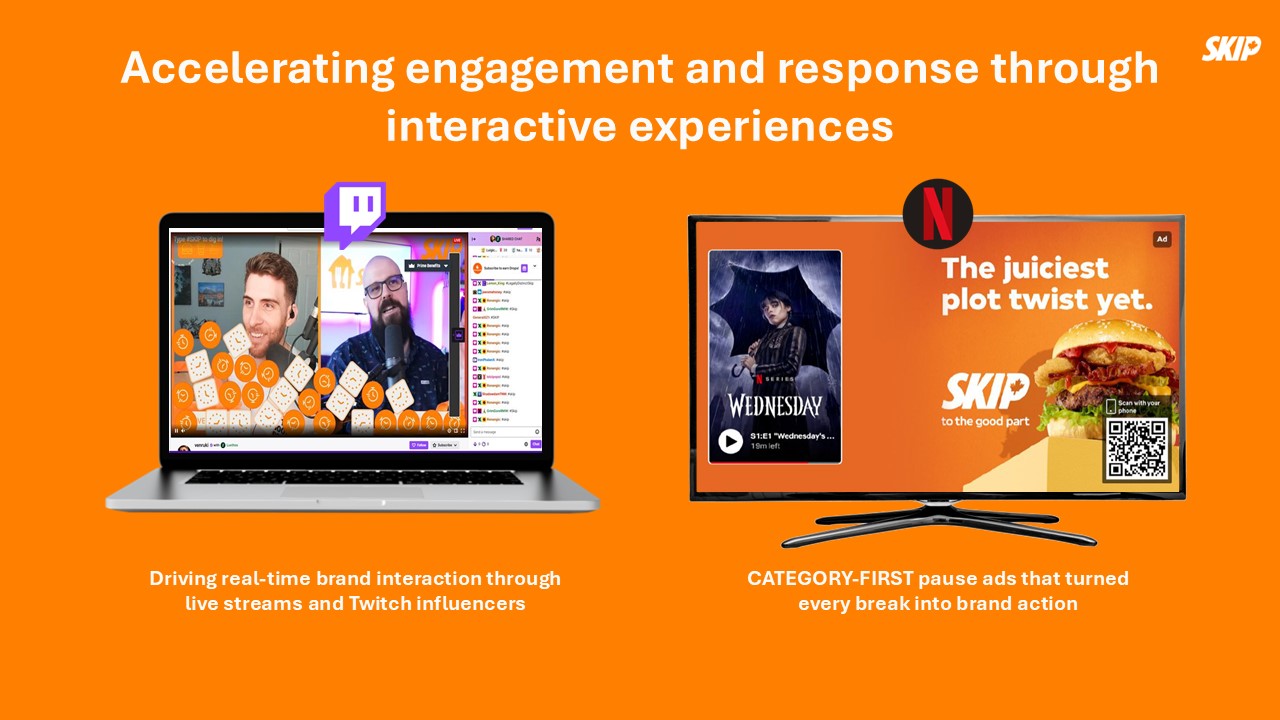
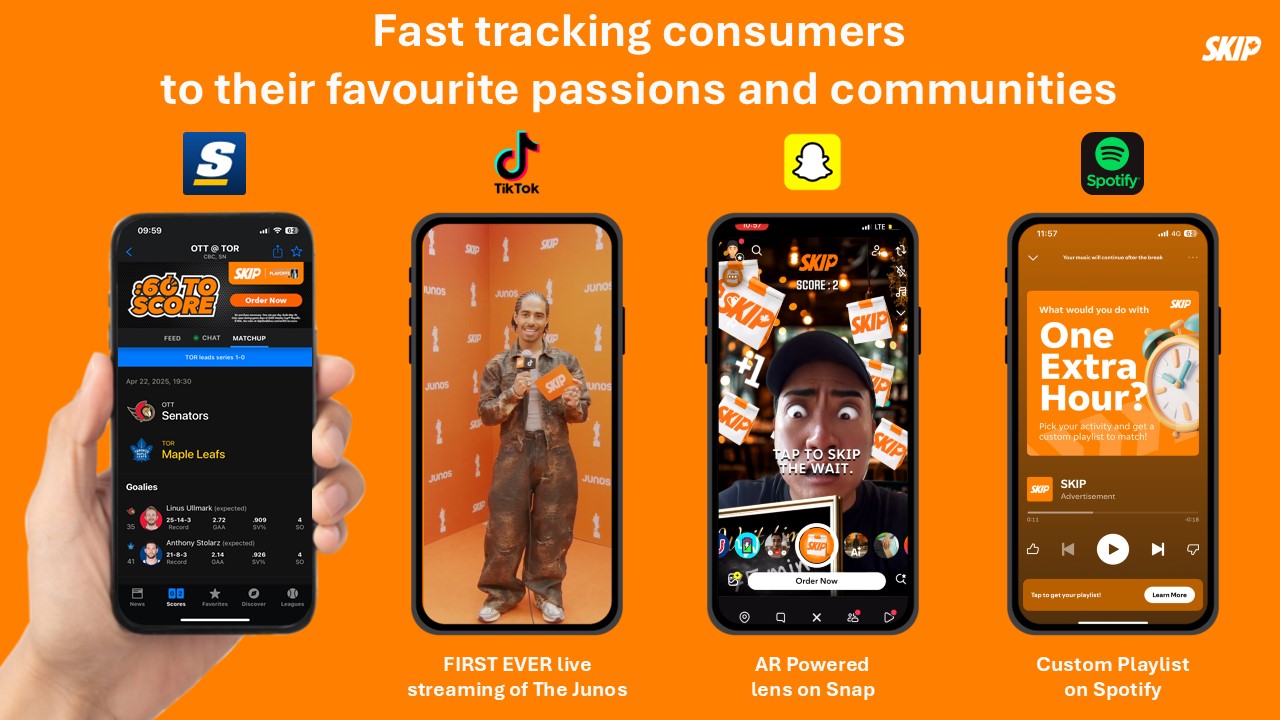
BronzeBest Launch/Relaunch
BronzeBest Integrated Campaign - Budget Over $250,000
Skip
"SKIP to the Good Part"
UM / Courage
"SKIP to the Good Part"
UM / Courage
In the period following the pandemic, with consumers still reluctant to go out, the demand for delivery apps skyrocketed. Skip The Dishes, a proud Canadian player, rode the wave. But as restrictions lifted and people returned to the outside world, the booming delivery industry cooled off, and Skip The Dishes felt the chill. To make matters worse, deep-pocketed global competitors, Uber Eats and DoorDash, suddenly doubled down on media spend, eroding Skip The Dishes’ share of voice. Brand awareness began to slip, affinity declined, and, critically, they were losing their local relevance. Canadians were increasingly less likely to see Skip The Dishes as one of their own, despite its head office located right here in Winnipeg.
The brand needed to reset, relaunch, and re-establish its presence in the hearts and minds of Canadians.
As the world reopened and consumers returned to their routines, they also returned to the grind: the crowded commutes, endless grocery lines, and the constant chaos and tedium of modern living.
Canadians’ desire for convenience had taken on a new meaning. It wasn’t just about saving time. It was about eliminating the drama, the delays, the unnecessary efforts that weighed them down, and the daily stresses that quietly drained their energy.
This is where Skip The Dishes found its fight. The battleground wasn’t finding convenience; it was fighting inconvenience!
First, the brand hit reset and dropped “The Dishes”, signaling a bold shift beyond food delivery, to a broader promise: to deliver whatever Canadians needed, whenever they needed it. Next, the campaign reframed Skip’s role — not just a delivery app, but a “bullsh*t eliminator” that dodged the drama and provided a trusted shortcut to the things that matter. Pivoting off the key insight, Skip became the antidote to daily micro-stressors and the hero to help Canadians skip to the good part.
To bring this to life, they launched the bold, media strategy to make Skip unskippable. Rather than simply chasing visibility, the strategy was to intercept moments of friction and need in real time and flip them into branded relief. Beyond reach, they set out to boost attention and engagement by meeting audiences “in the mess” and showcasing Skip’s promise to eliminate barriers, through both message and medium.
Rather than hyping generic, category table stakes of speed and convenience alone, they would outsmart the competition by using media to demonstrate Skip’s immediate utility and cultural relevance, within key moments of tension and desire — making it unskippable.
The agency harnessed the power of data to meticulously identify moments of peak receptivity and cultural relevance when consumers were most primed for impact. By decoding behavioural patterns, their data analysis categorized these moments into distinct emotional states. The agency used media to address each state with a relevant Skip solution: frustration with everyday barriers; anticipation for something better; procrastination and time-wasting; and indecision getting in the way of action. By targeting these contexts, consumers would welcome SKIP’s timely shortcut to get to the good stuff.
To maximize response, their insight-driven, “Skip To The Good Part” media power play targeted moments that Canadians wished they could have skipped, anchored by four key activation pillars. The first pillar was to dominate local connections by identifying barriers where life lagged/stress peaked. The second was to own “the wait” by tapping moments when we were waiting for the good part to begin. The third pillar was to accelerate engagement across digital communities through category-first tactics. The fourth and final pillar was to deepen connection to culture by embedding Skip into resonant cultural moments.
The agency’s cheeky “Shoulda Skipped It” video content launched with fan-favourite Jon Hamm, whose charm and humour perfectly embodied SKIP’s refreshed positioning, setting the tone and accelerating the momentum for the broader integrated campaign across the pillars.
The agency identified Skip’s priority communities and mapped them against real, everyday pain points. From streetcars and trains, to transit shelters and stations, gridlocked highways, and overcrowded malls — Skip dominated OOH in the exact places where consumers felt the energy drain, letting them know they could skip the hassle.
They targeted audiences when waiting for the “good part” to begin. In cinema, skip appeared right before showtime — reaching moviegoers in lobbies and seats as anticipation peaked.
On OLV and CTV, the agency captured attention through high-impact home screen takeovers and pre-roll across YouTube and premium partners, Amazon Prime, Netflix, Roku, LG, and Samsung. On Spotify, a custom interactive experience asked users what they would do with an extra hour — rewarding them with a personalized playlist from Skip, reinforcing Skip as a gateway to more of what they love.
The campaign drove reach and engagement via innovative, high-impact placements across key communities — Meta, TikTok, Snapchat, Twitch, and Reddit. As consumers doomscrolled, Skip met them with playful reminders and influencer-driven content calling out what they could’ve skipped. A custom gamified AR experience on Snapchat further deepened engagement, turning scroll time into play time.
Skip showed up in meaningful cultural spaces, including Sports & Entertainment, a cornerstone of identity and a powerful platform for connection. They dominated linear TV across top-tier programming, with a powerful presence around the NHL, NFL, CFL, and NBA and high-profile cultural events, like the JUNO Awards, to maximize reach and relevance.
The brand needed to reset, relaunch, and re-establish its presence in the hearts and minds of Canadians.
As the world reopened and consumers returned to their routines, they also returned to the grind: the crowded commutes, endless grocery lines, and the constant chaos and tedium of modern living.
Canadians’ desire for convenience had taken on a new meaning. It wasn’t just about saving time. It was about eliminating the drama, the delays, the unnecessary efforts that weighed them down, and the daily stresses that quietly drained their energy.
This is where Skip The Dishes found its fight. The battleground wasn’t finding convenience; it was fighting inconvenience!
First, the brand hit reset and dropped “The Dishes”, signaling a bold shift beyond food delivery, to a broader promise: to deliver whatever Canadians needed, whenever they needed it. Next, the campaign reframed Skip’s role — not just a delivery app, but a “bullsh*t eliminator” that dodged the drama and provided a trusted shortcut to the things that matter. Pivoting off the key insight, Skip became the antidote to daily micro-stressors and the hero to help Canadians skip to the good part.
To bring this to life, they launched the bold, media strategy to make Skip unskippable. Rather than simply chasing visibility, the strategy was to intercept moments of friction and need in real time and flip them into branded relief. Beyond reach, they set out to boost attention and engagement by meeting audiences “in the mess” and showcasing Skip’s promise to eliminate barriers, through both message and medium.
Rather than hyping generic, category table stakes of speed and convenience alone, they would outsmart the competition by using media to demonstrate Skip’s immediate utility and cultural relevance, within key moments of tension and desire — making it unskippable.
The agency harnessed the power of data to meticulously identify moments of peak receptivity and cultural relevance when consumers were most primed for impact. By decoding behavioural patterns, their data analysis categorized these moments into distinct emotional states. The agency used media to address each state with a relevant Skip solution: frustration with everyday barriers; anticipation for something better; procrastination and time-wasting; and indecision getting in the way of action. By targeting these contexts, consumers would welcome SKIP’s timely shortcut to get to the good stuff.
To maximize response, their insight-driven, “Skip To The Good Part” media power play targeted moments that Canadians wished they could have skipped, anchored by four key activation pillars. The first pillar was to dominate local connections by identifying barriers where life lagged/stress peaked. The second was to own “the wait” by tapping moments when we were waiting for the good part to begin. The third pillar was to accelerate engagement across digital communities through category-first tactics. The fourth and final pillar was to deepen connection to culture by embedding Skip into resonant cultural moments.
The agency’s cheeky “Shoulda Skipped It” video content launched with fan-favourite Jon Hamm, whose charm and humour perfectly embodied SKIP’s refreshed positioning, setting the tone and accelerating the momentum for the broader integrated campaign across the pillars.
The agency identified Skip’s priority communities and mapped them against real, everyday pain points. From streetcars and trains, to transit shelters and stations, gridlocked highways, and overcrowded malls — Skip dominated OOH in the exact places where consumers felt the energy drain, letting them know they could skip the hassle.
They targeted audiences when waiting for the “good part” to begin. In cinema, skip appeared right before showtime — reaching moviegoers in lobbies and seats as anticipation peaked.
On OLV and CTV, the agency captured attention through high-impact home screen takeovers and pre-roll across YouTube and premium partners, Amazon Prime, Netflix, Roku, LG, and Samsung. On Spotify, a custom interactive experience asked users what they would do with an extra hour — rewarding them with a personalized playlist from Skip, reinforcing Skip as a gateway to more of what they love.
The campaign drove reach and engagement via innovative, high-impact placements across key communities — Meta, TikTok, Snapchat, Twitch, and Reddit. As consumers doomscrolled, Skip met them with playful reminders and influencer-driven content calling out what they could’ve skipped. A custom gamified AR experience on Snapchat further deepened engagement, turning scroll time into play time.
Skip showed up in meaningful cultural spaces, including Sports & Entertainment, a cornerstone of identity and a powerful platform for connection. They dominated linear TV across top-tier programming, with a powerful presence around the NHL, NFL, CFL, and NBA and high-profile cultural events, like the JUNO Awards, to maximize reach and relevance.
Credits
SKIPRachel MacAdam, VP Marketing
Erin McGrath, Head of Engagement & Value Proposition
Travis Reason, Senior Manager, Media and Digital Growth
Eleanor Bothwell, Manager, Media and Performance Strategy
Autumn Linklater, Manager, Media and Performance Strategy
Bethany Skelton, Associate Director, Brand, Promotions and Sponsorships
Alessia Budaci, Marketing Lead, Brand Strategy
Trevor Tuminski, Associate Creative Director
David Kotschorek, Associate Creative Director
UM
Rob Perri, EVP, Client Business Partner
Paloma Jimenez, Sr Director, Connections Planning
Francesco Giacobbe, Sr Director, Digital
Daniel Audia, Manager, Connections Planning
Pravaen Birk, Supervisor, Connections Planning
Nicole Kirin, Media Assistant
Rafaela Steiner, Sr Planner, Connections Planning
Sonya Vieira, Director, Integrated Investments
Arianna Conciatori, Manager, Integrated Investments
Courage
Dhaval Bhatt: Founder + CCO
Joel Holtby: Founder + CCO
Tom Kenny: Partner + CSO
Niki Sahni: Partner + President
Rami Dudin: Strategy Director
Sammy Lo: Art Director
Emma Lorenzi: Writer
Saloni Wadehra: Group Account Director
Emily Broad: Account Supervisor
Jordan McConnell: Account Executive
Clair Galea: Executive Producer + Head of Production
Adriana Laborde: Senior Producer
